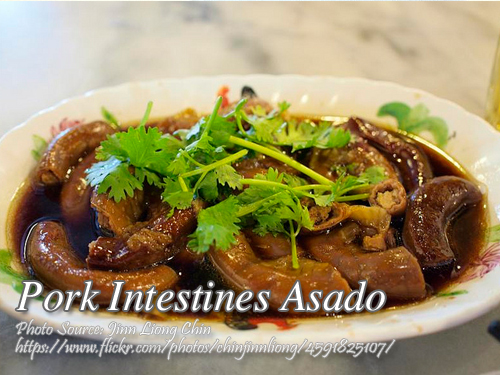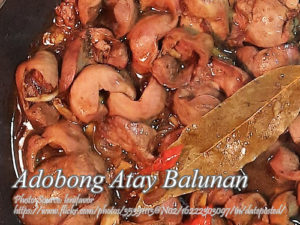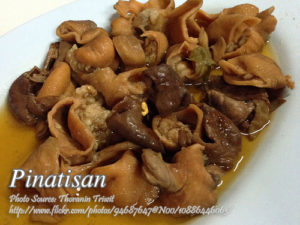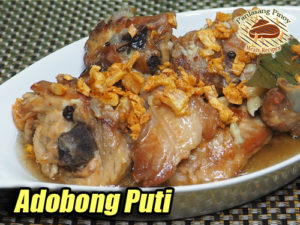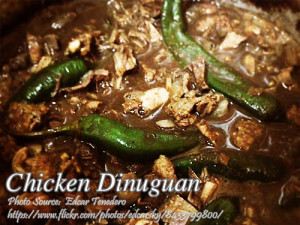A savory and delicious pork intestine dish that you can cook any day. Since it is like cooking adobo, because of the simplicity of cooking this recipe and the ingredients are not hard to find. That is, if you will purchase this on a wet market since supermarkets seldom sell pork intestines. The only tedious part is cleaning the pork intestines to remove the slimy and gooey contents. If the preparation and cleaning is not good enough, it will have a bitter after taste which might ruin you dish.
Pork Intestines Asado: A Mouth-Watering Pinoy Favorite
I always grew up knowing that family meals were never just mere appeasement of hunger; they were traditions. Among the delicious dishes, I have nostalgic memories of is my Uncle Lito’s passing of a recipe for pork intestines asado down to us, which he learned when he worked as a cook in a local carinderia in Pampanga. It’s a dish that, many might find bizarre to their ears, but Filipinos treat it as one of the delectable treasures that are highly cared for and the meal brings warmth, nostalgia, and a sense of community.
Though it may not be one of the most common dishes in the supermarket, you’ll surely find pork intestines at the wet markets within your place. Uncle Lito always reminded me that the secret to this dish lies in the cleaning process-get that wrong, and you might end up with a bitter aftertaste that could spoil the meal.
The Humble Origins of Pork Intestines Asado
Definitely not a common candidate for comfort food when you think of the Philippines, pork intestines, however, have been part of our culinary tradition. Filipinos in the past utilized every part of the pig and maximized it to give sustenance with great flair, whether it is in sisig or dinuguan, so nothing really is wasted. Cooking this dish is, in many ways, a tribute to our forefathers because they knew how to use all parts of the animal for something palatable.
My cousin Marites returned from Iloilo last year bringing with her a variation of this recipe. She told me of how her grandmother used to slow-cook the intestines for hours to make it tender and flavorful and a perfect dish for the whole family’s feast. This reminds me of our family gatherings in my land because of the smell of cooking soy sauce and bay leaves. Even before it hits the plate, you could already taste the meal.
The Hardest Part: The Cleaning of Pork Intestines
The hardest part of the dish is probably the cleaning of pork intestines. And that is very important because it can make the dish taste differently. You have to be very detail-oriented when doing it. I remember when I first tried making this dish for myself. My grandmother, Lola Charing, stood beside me, shaking her head over my fumbling as I cleaned it all up. She showed me how to remove the slimy layer from it and how to ensure that all such residues do not cause the preparation to be disgusting in itself. That is tiresome, of course, but that’s where the love of cooking comes into play. If you’re diligent, then the end result will be worth it.
You start by boiling the intestines for a few minutes, helping to soften them, and makes them easier to clean, so that ends up being my mother’s trick. Once you got rid of all the impurities, washing thoroughly so the inside and the intestinal lining are spotless, the cooking part becomes much, much easier compared to the actual cleaning process.
Cooking the Dish: Easy Yet Delicious
Cooking pork intestines is almost as easy to do compared with making adobo. All that you would have to do once you clean them is simmer the intestines in soy sauce, sugar, and water. This way, the meat soaks in all the flavors to become tender and very savory-a taste that we all love. When I cook this dish, I tend to stay over the stove to stir it as often as I can, but my brother Ricky never fails to do that when he pays a visit from Davao. He says it’s therapeutic— watching the sauce thicken and the meat become soft with every passing minute.
When the sauce starts to thicken, you add in your spices: the peppercorns, bay leaf, a pinch of salt, and something that my Uncle Lito always swore by: sanque or star anise. This spice makes the dish slightly sweet and aromatic, carrying the dish beyond being just another stew. Uncle Lito said this was just one trick of many he learned from his Chinese neighbors back in Pampanga, where fusion dishes are quite common. I just love how Filipino food borrowed so much from other cultures while adapting and fusing them; every meal is but a story of history and influences.
Serving It Right: The Perfect Companion for Pickled Sides
When finally served, the intestines are cut up into palatable pieces; the sauce’s rich flavor is savory and slightly sweet. At home, we always serve it with either atchara (pickled papaya) or burong labanos (pickled radish). These vinegar flavors are very tight for the better because of the sweet taste of the food itself. It is like a mouthful of contrasts; sometimes you are bound to end up biting into the soft intestines and sweet soy sauce, that sharp vinegar kick from the pickles. That’s probably why it tops the list at family reunions.
I can still remember coming home one summer from Cebu with my sister Roselyn, surprising us with her own take of the dish. She did not serve it steaming hot with rice but served it with steaming puto, and honestly speaking, it was a revelation. Those fluffy rice cakes do absorb that sauce, making each mouthful heavenly. It’s little tweaks like this that keep traditional recipes in an evolving pattern, never stuck to one generation or another.
Heart of Filipino Home Cooking
Basically, pork intestines asado is more than just a dish. It can be a reminder of the value of time, effort, and tradition in Filipino-style cooking. Actually, this one requires patience in preparation, but really, this is what makes the meal more rewarding. Because it reminds us of our past-to those times when everything in the kitchen did not go to waste and where every dish was prepared with love.
Next time you go to the wet market, I’d really recommend trying this. Chances are you might end having it on your dining table, just like my family did.
How to Cook Pork Intestines Asado
Ingredients
- 1 kilo pork intestines small intestines
- 1/2 cup brown sugar
- 5 to 6 cloves garlic minced
- 1/2 cup water
- 1 Tbsp. salt
- 2 Tbsp. soy sauce
- 1/2 pc bay leaf
- 1 pc petal sanque or star anise
- 1/2 tsp. ground pepper
- 1 Tbsp peppercorn
Instructions
How to Cook Pork Intestines Asado:
- Clean intestines very well. Boil in water for 3 minutes. Drain.
- Place in a pan, add soy sauce, sugar and water. Then boil.
- Lower temperature then continue cooking until sauce thickens.
- Add 1 more cup water, salt, peppercorns, pepper, sanque, and bay leaf. Cover.
- Simmer for 1 hour or until done.
- Slice intestines into 1 and 1/2 inch long. Serve with pickled papaya or pickled radish.
Notes
Cooking Tips:
Thoroughly Clean the Pork Intestines
The intestines must first be boiled then scrubbed so that all the dirt is loosened off, followed by thorough running water washing. It is preferred to soak the guts in salt solution first for cleanliness and to get rid of stench odors.Slow Simmer for Tender Texture
One needs to be patient in the preparation process in order to get it just right to such texture that falls tenderly and melts in the mouth. Then bring the sauce to the boil and reduce the heat, thus putting it to simmer for almost an hour. This slow cooking process aids in the proper absorption of flavors while ensuring that the meat remains soft.Harmonize for the Blend of Sweet and Salty Flavours
Soy sauce and sugar balance the overall flavor, but the degree of sweetness naturally will depend on your preference: adding more sugar to create a sweeter end product or using less to make it saltier. Adding star anise or bay leaves to the simmering process will give you dimensions and depths in the sauce.
